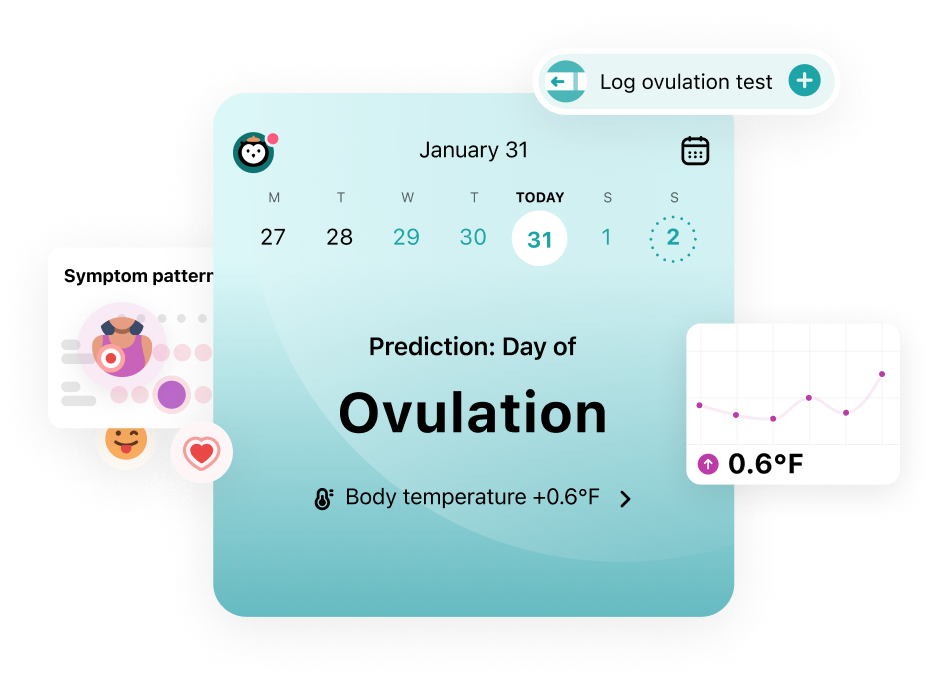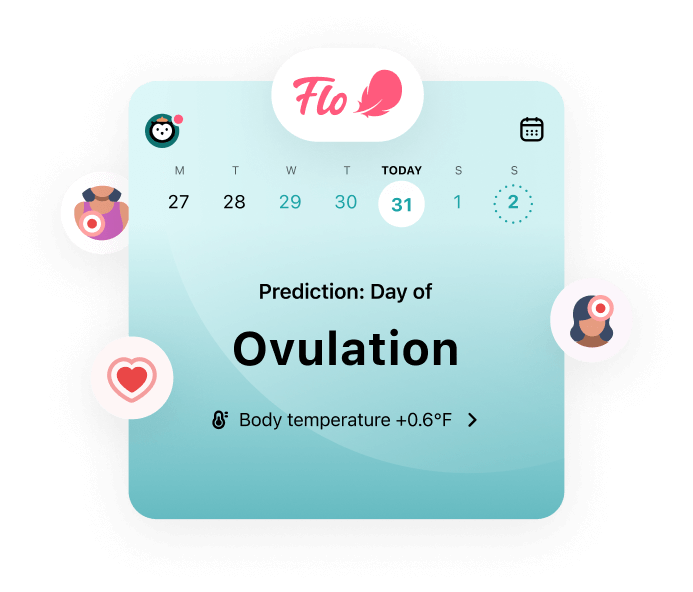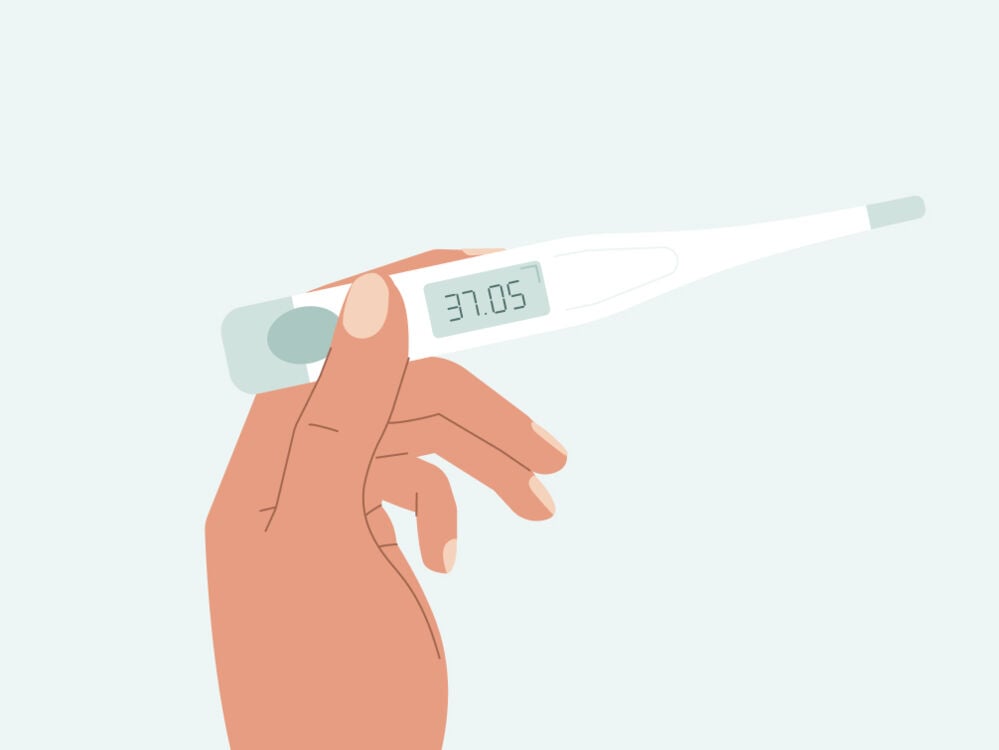You might have heard that tracking your basal body temperature (BBT) can help you conceive, but is that really the case? And how do you do it? Here, a Flo expert explains everything you need to know about BBT.
-
Tracking cycle
-
Getting pregnant
-
Pregnancy
-
Help Center
-
Flo for Partners
-
Anonymous Mode
-
Flo app reviews
-
Flo Premium New
-
Secret Chats New
-
Symptom Checker New
-
Your cycle
-
Health 360°
-
Getting pregnant
-
Pregnancy
-
Being a mom
-
LGBTQ+
-
Quizzes
-
Ovulation calculator
-
hCG calculator
-
Pregnancy test calculator
-
Menstrual cycle calculator
-
Period calculator
-
Implantation calculator
-
Pregnancy weeks to months calculator
-
Pregnancy due date calculator
-
IVF and FET due date calculator
-
Due date calculator by ultrasound
-
Medical Affairs
-
Science & Research
-
Pass It On Project New
-
Privacy Portal
-
Press Center
-
Flo Accuracy
-
Careers
-
Contact Us
What is basal body temperature, and how do you measure it?


Every piece of content at Flo Health adheres to the highest editorial standards for language, style, and medical accuracy. To learn what we do to deliver the best health and lifestyle insights to you, check out our content review principles.
Understanding your cycle has lots of benefits, from knowing when you’re most fertile to when you might be a little crankier than usual (thanks, PMS).
Tracking your basal body temperature (BBT) is one of the ways you can get to know your cycle better. Your BBT increases just after ovulation, so by recording it each day for a few cycles, you can learn when you tend to ovulate.
But your BBT isn’t the same as your regular temperature, and you have to measure it in a certain way to get an accurate reading. Here, Flo expert Dr. Charlsie Celestine, obstetrician and gynecologist, New Jersey, US, explains exactly how to measure your BBT. She also explains how BBT tracking can indicate when ovulation happens if you’re trying to conceive — and even when you might be pregnant.
However, it’s important to note that you should never use BBT as a method of birth control. Its effectiveness is limited as many factors can influence your body temperature, including stress and having a fever.
Key takeaways
- Measuring BBT can help you understand when you ovulate and when your most fertile days are.
- Your temperature rises very slightly once ovulation has happened and stays high until just before you get your period.
- If you conceive, your temperature will remain high — so your BBT could even provide an early indication that you’re pregnant.
- However, certain factors can impact the accuracy of your readings, like sleeplessness, illness, and drinking alcohol. That’s why you should never use BBT as a method of birth control.

 Over
7.8M
ratings averaging
4.8/5
*
Over
7.8M
ratings averaging
4.8/5
*
Understand your fertility better with the Flo app
- Learn more about your fertility signals
- Improve ovulation predictions by tracking temperature via Apple Watch
- Log your ovulation test results
 Over
7.8M
ratings averaging
4.8/5
*
Over
7.8M
ratings averaging
4.8/5
*

Trying to conceive?
The Flo app can help you better understand your fertility

 Over
7.8M
ratings averaging
4.8/5
*
Over
7.8M
ratings averaging
4.8/5
*
Understand your fertility better with the Flo app
- Learn more about your fertility signals
- Improve ovulation predictions by tracking temperature via Apple Watch
- Log your ovulation test results
What is basal body temperature?
Your BBT refers to your resting body temperature or your lowest temperature when you are completely still (for example, after three consecutive hours of sleep).
What is it used for?
BBT helps you understand when you tend to ovulate, which is when an egg is released from one of your ovaries. The egg will live for 24 hours, and if it gets successfully fertilized by a sperm during this time, then you will conceive. That means the time surrounding ovulation is when you are most fertile.
So if you’re trying for a baby, measuring your BBT could, in theory, help you know when to have lots of sex. On the flip side, it could potentially help you know when to avoid getting frisky without contraception if you’re not looking to conceive. However, it’s important to remember that experts don’t recommend using BBT as a method of birth control or as a surefire way to help you conceive.
How does your BBT change after ovulation?
After an egg has been released, your body’s resting temperature often increases very slightly by around 0.5 to 1 F (0.22 to 0.56 C). This is due to the hormone progesterone, which spikes just after ovulation to help your body prepare for a possible pregnancy. A slight rise in body temperature is a side effect of this progesterone increase. Your temperature then remains high until the end of your menstrual cycle — usually a few more days.
How to use BBT to predict ovulation
The important thing to remember about BBT is that it can help you know when ovulation has already happened, not when it’s about to (like an ovulation kit or a period tracking app like Flo can). This means you have to track your BBT for at least three cycles, looking for patterns to be able to predict when you might ovulate.
Flo can make this easier for you because you can log your BBT in the app, and it will create a handy BBT ovulation chart for you.
You can also create a chart yourself. “The X axis of a graph is menstrual cycle days, with day one being the first day of your period. And the Y axis is where you plot your temperature,” says Dr. Celestine. Before you get started, our period calculator can help you figure out when your next period is due.
When tracking your BBT, you might notice that your temperature varies slightly each day, but there is likely to be a noticeable spike if ovulation has occurred. When this spike is followed by at least three days of higher readings in a row, it means you’ve ovulated.
“After creating these BBT charts for a few months, you may see a pattern where your temperature rises about midway through your cycle,” says Dr. Celestine. “Once you notice this trend, then you know your most fertile window is about three to five days before that temperature rise happens.” This is because sperm can live for up to five days inside of your body, increasing the window of time you have to conceive.
As an alternative to tracking basal temperature, you can also try our ovulation calculator to predict when you might ovulate. Or if you’re already logging your period dates, the Flo app can predict when you’re ovulating — no thermometer necessary. Finally, to know for certain when you’re ovulating, pick up an ovulation test from your pharmacy, which works by measuring the level of hormones in your pee.
Why measure your basal body temperature instead of normal body temperature?
“The temperature increase you get with ovulation is only very slight,” says Dr. Celestine. “This means you can’t use your day-to-day temperature, as it goes up and down for a myriad of reasons throughout the day.”
As the rise in temperature following ovulation is often less than half a degree, it’s important to use the right kind of thermometer for tracking BBT. This is a basal thermometer, which is the most accurate because it shows two decimal places. Typical thermometers only show one, so they aren’t always sensitive enough to reveal the shift.

Take a quiz
Find out what you can do with our Health Assistant
When to check your BBT
You should try to check your BBT the moment you wake up each morning before getting out of bed. This is because getting up and moving around can raise your body temperature and interfere with your results. Even talking or lying in bed awake for several minutes can impact your temperature (crazy, right?). So, for the most accurate results, try to reach for your thermometer as soon as you wake up.
Tracking BBT after a sleepless night
To get the most accurate reading possible, you need to test after at least three consecutive hours of sleep. If you’ve had a sleepless night and haven’t managed to get those three hours in, don’t panic — we’ve all been there. Just make a note of it next to your reading.
“If you have a sleepless night, [the reading is] going to be more inaccurate,” says Dr. Celestine. “So if you are someone who is prone to sleepless nights, this definitely isn’t the ovulation tracking method for you.”
We know how difficult and frustrating it can be to experience sleepless nights. If you’re finding a lack of sleep is interfering with your day-to-day life or you have any concerns, always be sure to reach out to your doctor. The good news is that there are plenty of treatment options available to help you get the rest you need, from cognitive behavioral therapy to various medications.
How to check your BBT accurately
Consistency is key when it comes to BBT tracking, so always try to measure it at the same time with the same thermometer. This might sound stressful at first, but before long, it’ll likely feel like second nature.
Detecting pregnancy on the BBT chart
After ovulation, your BBT will eventually drop back down again to your baseline temperature when your period starts. However, if you get pregnant, your BBT will stay elevated. So, if you’ve noticed a raised temperature for 18 days or more, it could be one of the very early signs of pregnancy.
It’s worth keeping in mind, however, that this isn’t an accurate predictor of pregnancy. “I would not use BBT tracking to test for pregnancy,” says Dr. Charlsie. “If your temperature does not go back down to baseline after ovulation, it could be a pregnancy indication, but it’s not reliable.” Remember, the only way to confirm pregnancy is with a test on or after the first day of your missed period — so a trip to the drugstore may be in order.
When does BBT drop if you’re not pregnant?
If you’re not pregnant, then you’ll notice your BBT fall back down to your baseline, which usually happens a day or two before your period arrives. So, if you have a 28-day cycle, you’ll likely see the temperature drop around days 26 to 27.
Trying for a baby can feel like an emotional roller coaster, so be kind to yourself. If you haven’t conceived this cycle, then remind yourself that it’s often not as easy to get pregnant as sex education classes led us to believe. The truth is that it can take time. However, if you’ve been trying for a year (or six months if you’re over 35), then reach out to your doctor for support and advice. You are not alone.
What does a complete basal body temperature chart look like?
A complete BBT chart should show two distinct phases: before ovulation and after ovulation. While the line might go up and down slightly from day to day, the second phase of your chart is likely to show a small but noticeable rise.
If you find that your chart goes up and down without any clear point of change, it could be a sign that you haven’t ovulated during that cycle. If you’re concerned that this might be the case, chat with your doctor about it. If it keeps happening, they may decide to do tests to investigate further. This might sound scary, but keep in mind that BBT tracking can often be inaccurate, and the rise in temperature following ovulation is small. So try not to worry, and book a checkup with your health care provider.
When is a BBT chart inaccurate?
We’ve already explored how sleeplessness can interfere with the accuracy of your BBT tracking (as if a sleepless night isn’t bad enough already!). Other things that can tamper with your temperature include:
- Having a fever
- Experiencing high stress
- Breastfeeding
- Drinking alcohol
- Taking certain medications, such as fluoxetine
“BBT is influenced by so many factors, from sleepless nights to travel to irregular periods and stress,” says Dr. Celestine. “To be honest, it’s not an ovulation tracking method that I would recommend. It’s extremely unreliable and inaccurate for most people because of all the normal day-to-day factors that can affect your temperature.” This means it’s also not an accurate method of birth control, too.
More FAQs
What is a normal basal body temperature?
Most people have a BBT of around 96 to 98 F (35.5 to 36.6 C) before ovulation and of roughly 97 to 99 F (36.1 to 37.2 C) after. But the exact rise in temperature is different for everyone.
Where do you put a basal thermometer?
You can measure BBT by putting the thermometer in your mouth or your bottom (rectum) — however, most people (understandably) choose the former.
Does basal body temperature rise after implantation?
There’s no evidence to suggest that your BBT will rise after implantation, which is when a fertilized egg burrows into the wall of your uterus. Measuring your BBT is, therefore, not a reliable way to tell if you’re pregnant.


Hey, I'm Anique
I started using Flo app to track my period and ovulation because we wanted to have a baby.


The Flo app helped me learn about my body and spot ovulation signs during our conception journey.


I vividly
remember the day
that we switched
Flo into
Pregnancy Mode — it was
such a special
moment.
Real stories, real results
Learn how the Flo app became an amazing cheerleader for us on our conception journey.
References
“Basal Body Temperature.” Cleveland Clinic, my.clevelandclinic.org/health/articles/21065-basal-body-temperature. Accessed 30 Nov. 2023.
“Basal Body Temperature for Natural Family Planning.” Mayo Clinic, 10 Feb. 2023, www.mayoclinic.org/tests-procedures/basal-body-temperature/about/pac-20393026.
Bross, R., and L. J. Hoffer. “Fluoxetine Increases Resting Energy Expenditure and Basal Body Temperature in Humans.” The American Journal of Clinical Nutrition, vol. 61, no. 5, May 1995, pp. 1020–25, https://doi.org/10.1093/ajcn/61.5.1020.
“Can Tracking Your Basal Body Temperature Help You Conceive?” Cleveland Clinic, 7 May 2021, health.clevelandclinic.org/can-tracking-your-basal-body-temperature-help-you-conceive.
“Fertility Awareness-Based Methods of Family Planning.” The American College of Obstetricians and Gynecologists, Jan. 2019, www.acog.org/womens-health/faqs/fertility-awareness-based-methods-of-family-planning.
“Fertilization and Implantation.” Mayo Clinic, www.mayoclinic.org/healthy-lifestyle/pregnancy-week-by-week/multimedia/fertilization-and-implantation/img-20008656. Accessed 30 Nov. 2023.
“How Can I Tell When I’m Ovulating?” NHS, www.nhs.uk/common-health-questions/sexual-health/how-can-i-tell-when-i-am-ovulating/. Accessed 30 Nov. 2023.
“Insomnia.” Mayo Clinic, 15 Oct. 2016, www.mayoclinic.org/diseases-conditions/insomnia/diagnosis-treatment/drc-20355173.
Oyelowo, Tolu. “Chapter 5: Birth Control.” Mosby’s Guide to Women’s Health, 2007, pp. 25–35, https://doi.org/10.1016/B978-032304601-5.50006-X.
“Periods and Fertility in the Menstrual Cycle.” NHS, www.nhs.uk/conditions/periods/fertility-in-the-menstrual-cycle/. Accessed 30 Nov. 2023.
“Periods and Pregnancy.” NHS Inform, 21 Dec. 2022, www.nhsinform.scot/healthy-living/womens-health/girls-and-young-women-puberty-to-around-25/periods-and-menstrual-health/periods-and-pregnancy/.
“Sperm: How Long Do They Live after Ejaculation?” Mayo Clinic, 5 May 2022, www.mayoclinic.org/healthy-lifestyle/getting-pregnant/expert-answers/pregnancy/faq-20058504.
Steward, Kaitlyn, and Avais Raja. “Physiology, Ovulation, and Basal Body Temperature.” StatPearls, StatPearls Publishing, 17 July 2023, www.ncbi.nlm.nih.gov/books/NBK546686/.
History of updates
Current version (19 December 2023)
Published (01 October 2018)
In this article

Get your personal guide to fertility
-
Learn how to read your body's ovulation signals
-
Find daily conception tips from our experts
-
Chat with others who are trying to get pregnant




